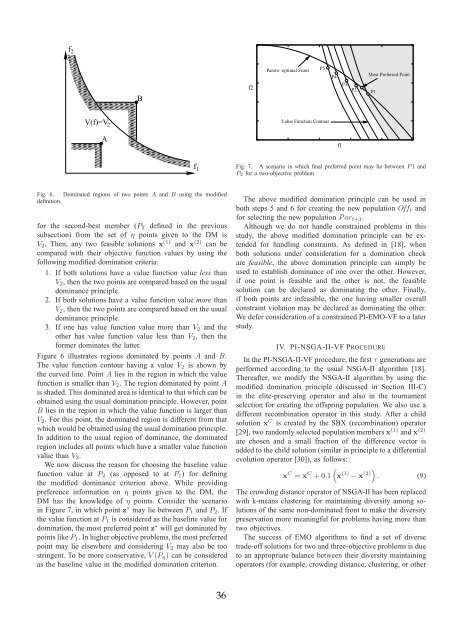Progressively Interactive Evolutionary Multi-Objective Optimization ...
Progressively Interactive Evolutionary Multi-Objective Optimization ...
Progressively Interactive Evolutionary Multi-Objective Optimization ...
Create successful ePaper yourself
Turn your PDF publications into a flip-book with our unique Google optimized e-Paper software.
f 2<br />
V(f)=V 2<br />
A<br />
Fig. 6. Dominated regions of two points A and B using the modified<br />
definition.<br />
for the second-best member (P2 defined in the previous<br />
subsection) from the set of η points given to the DM is<br />
V2. Then, any two feasible solutions x (1) and x (2) can be<br />
compared with their objective function values by using the<br />
following modified domination criteria:<br />
1. If both solutions have a value function value less than<br />
V2, then the two points are compared based on the usual<br />
dominance principle.<br />
2. If both solutions have a value function value more than<br />
V2, then the two points are compared based on the usual<br />
dominance principle.<br />
3. If one has value function value more than V2 and the<br />
other has value function value less than V2, then the<br />
former dominates the latter.<br />
Figure 6 illustrates regions dominated by points A and B.<br />
The value function contour having a value V2 is shown by<br />
the curved line. Point A lies in the region in which the value<br />
function is smaller than V2. The region dominated by point A<br />
is shaded. This dominated area is identical to that which can be<br />
obtained using the usual domination principle. However, point<br />
B lies in the region in which the value function is larger than<br />
V2. For this point, the dominated region is different from that<br />
which would be obtained using the usual domination principle.<br />
In addition to the usual region of dominance, the dominated<br />
region includes all points which have a smaller value function<br />
value than V2.<br />
We now discuss the reason for choosing the baseline value<br />
function value at P2 (as opposed to at P1) for defining<br />
the modified dominance criterion above. While providing<br />
preference information on η points given to the DM, the<br />
DM has the knowledge of η points. Consider the scenario<br />
in Figure 7, in which point z ∗ may lie between P1 and P2. If<br />
the value function at P1 is considered as the baseline value for<br />
domination, the most preferred point z ∗ will get dominated by<br />
points like P1. In higher objective problems, the most preferred<br />
point may lie elsewhere and considering V2 may also be too<br />
stringent. To be more conservative, V (Pη) can be considered<br />
as the baseline value in the modified domination criterion.<br />
B<br />
f 1<br />
36<br />
f2<br />
Pareto−optimal Front<br />
P5<br />
Value Function Contour<br />
P4<br />
f1<br />
P3<br />
P2 P1<br />
Most Preferred Point<br />
Fig. 7. A scenario in which final preferred point may lie between P 1 and<br />
P2 for a two-objective problem.<br />
The above modified domination principle can be used in<br />
both steps 5 and 6 for creating the new population Offt and<br />
for selecting the new population P art+1.<br />
Although we do not handle constrained problems in this<br />
study, the above modified domination principle can be extended<br />
for handling constraints. As defined in [18], when<br />
both solutions under consideration for a domination check<br />
are feasible, the above domination principle can simply be<br />
used to establish dominance of one over the other. However,<br />
if one point is feasible and the other is not, the feasible<br />
solution can be declared as dominating the other. Finally,<br />
if both points are infeasible, the one having smaller overall<br />
constraint violation may be declared as dominating the other.<br />
We defer consideration of a constrained PI-EMO-VF to a later<br />
study.<br />
IV. PI-NSGA-II-VF PROCEDURE<br />
In the PI-NSGA-II-VF procedure, the first τ generations are<br />
performed according to the usual NSGA-II algorithm [18].<br />
Thereafter, we modify the NSGA-II algorithm by using the<br />
modified domination principle (discussed in Section III-C)<br />
in the elite-preserving operator and also in the tournament<br />
selection for creating the offspring population. We also use a<br />
different recombination operator in this study. After a child<br />
solution x C is created by the SBX (recombination) operator<br />
[29], two randomly selected population members x (1) and x (2)<br />
are chosen and a small fraction of the difference vector is<br />
added to the child solution (similar in principle to a differential<br />
evolution operator [30]), as follows:<br />
x C = x C + 0.1<br />
<br />
x (1) − x (2)<br />
. (9)<br />
The crowding distance operator of NSGA-II has been replaced<br />
with k-means clustering for maintaining diversity among solutions<br />
of the same non-dominated front to make the diversity<br />
preservation more meaningful for problems having more than<br />
two objectives.<br />
The success of EMO algorithms to find a set of diverse<br />
trade-off solutions for two and three-objective problems is due<br />
to an appropriate balance between their diversity maintaining<br />
operators (for example, crowding distance, clustering, or other
















